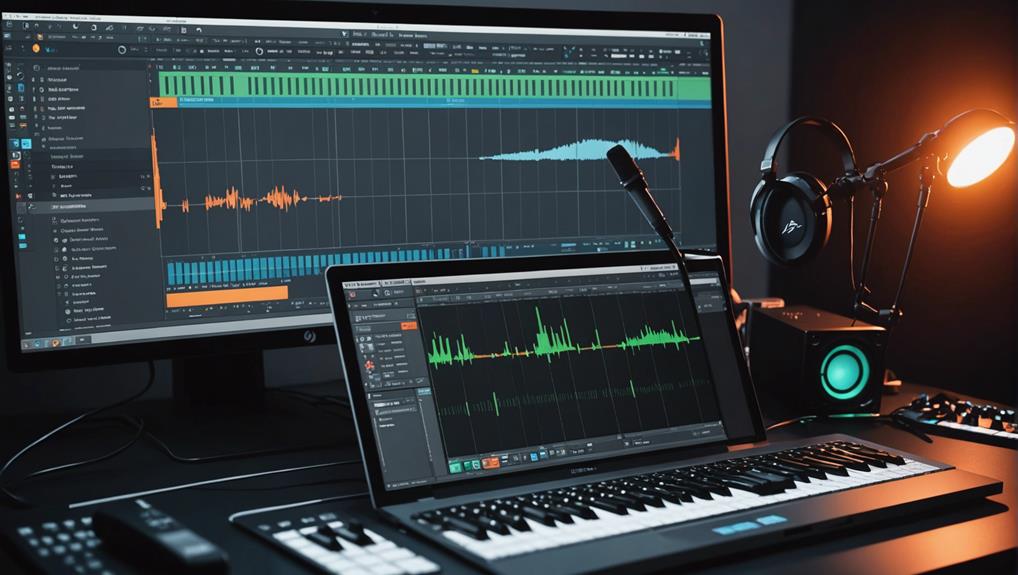Changing colors in FL Studio is straightforward and can enhance your music production experience. Start by accessing the Options menu to explore both user-created and default themes. From there, use the Hue Knob, Saturation, and Brightness settings to adjust the overall appearance to your liking. Finally, customize the text color and UI elements for improved visibility and personal style. Remember, you can reset to default settings anytime for a fresh start. To reveal more tips for optimizing your workflow and customization options, follow along for additional insights.
Key Takeaways
- Access the Options menu in FL Studio to explore and select from available themes for color changes.
- Adjust the Hue, Saturation, Brightness, and Contrast settings for personalized color customization.
- Change specific Text color to enhance readability in the chosen theme.
- Save and manage user-created themes in the Documents/Image-Line/FL Studio/Settings/themes directory.
- Reset to default settings if needed for a fresh start or troubleshooting visibility issues.
Finding Themes in FL Studio
Have you ever wondered how to personalize your experience in FL Studio? Finding themes is a straightforward process that enhances your workflow.
To begin, navigate to the Options menu, where you can access the new Theme Settings. Here, you’ll discover a variety of user-created and default themes, such as the popular Ultra Green and Purple VA.
Additionally, you can explore a theme kit available on BeatStars, which provides over ten unique themes for further customization.
Themes are conveniently organized in the Presets window, allowing easy access to all options from Factory, User, and Downloaded themes.
User themes are typically saved in the path: Documents/Image-Line/FL Studio/Settings/themes, making them easily manageable and accessible.
Adjusting Color Settings
To create a visually appealing and functional workspace in FL Studio, adjusting color settings is vital. The Hue Knob allows users to modify the overall ambient color, but its impact is lessened at low saturation levels.
Increasing Saturation can yield a more vibrant theme, enhancing visual engagement. Brightness is essential for visibility; setting it too low may obscure grid lines and UI elements, hindering workflow.
Additionally, adjusting Contrast affects the darkness of visuals and should be balanced with brightness and saturation for ideal results. Customizing Text color can also improve readability, ensuring that important information stands out.
If necessary, users can revert to default colors for a quick reset, facilitating efficient workflow automation.
Customizing Text and Elements
Customizing text and UI elements in FL Studio considerably enhances the overall usability and aesthetic of the workspace. Adjusting text color improves visibility, especially in darker themes, while light mode guarantees clarity under bright conditions. By setting specific RGB values or Hex codes, users can achieve precise customizations that suit their preferences.
| Element | Customization Options |
|---|---|
| Text Color | Default or personalized hues |
| Automation Clips Use | Custom palettes or defaults |
| Browser Text Color | Enhanced readability |
| UI Elements | Tailored to your workflow |
| Overall Appearance | Cohesive and appealing design |
These options allow for a tailored experience, making your workspace not only functional but visually appealing.
Frequently Asked Questions
How to Change Colors in FL Studio?
To enhance your FL Studio experience, explore color palette customization through theme inspiration ideas. Utilize interface design tips, such as adjusting saturation and employing Hex Color Values, to create a visually appealing and functional workspace.
How Do I Change Steps in FL Studio?
To efficiently change steps in FL Studio, utilize step sequencing techniques alongside music production tips. Familiarize yourself with FL Studio shortcuts to streamline the process, enhancing your workflow and improving overall productivity in music creation.
How Do I Color Code in FL Studio?
Color coding techniques in FL Studio enhance project organization. Utilize the color palette customization for Mixer and Playlist tracks, modify step sequencer colors, and adjust FL Studio themes for a cohesive visual experience throughout your projects.
How to Make FL Studio Purple?
To achieve a purple aesthetic in FL Studio, explore various themes and custom skins. Adjust the color palette by manipulating hue and saturation settings, and consider using specific hex values for precise purple shades to enhance your workspace.
Conclusion
To sum up, altering color settings in FL Studio enhances the user experience and can lead to improved workflow efficiency. By exploring available themes, adjusting color settings, and customizing text and elements, users can create a personalized environment that fosters creativity and comfort. Emphasizing the significance of visual aesthetics in music production, these modifications not only reflect individual preferences but also contribute to a more enjoyable and productive working atmosphere within the software.



